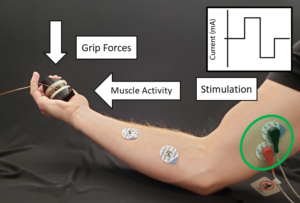
Roughly 80% of stroke patients experience hemiparesis, a condition that causes weakness on one side of the body and can affect every area of life, from walking to eating to dressing. Recovering and living with one-sided weakness requires patients to engage in regular rehabilitative exercise and therapy to regain strength. One popular treatment for hemiparesis is Mirror Therapy, a therapy in which a mirror is placed between a patient’s arms or legs, allowing the reflection of their moving limb to give the illusion of normal movement in the affected limb. The visual feedback received from the therapy causes mirror neurons in the brain to fire, sparking a rewiring process called neuroplasticity that is essential to stroke recovery. Neuroplasticity enables healthy parts of the brain to take over some of the lost function that damaged brain tissue can no longer carry out, improving movement and sensation and relieving pain in the affected limb.
Electrical and computer engineering Ph.D. student and Graduate Research Assistant in the Utah NeuroRobotics Lab Marshall Trout is developing a non-invasive system (pictured below) to reanimate a paretic hand that improves visual feedback therapy and rehabilitation of fine motor functions in hemiparetic patients. Trout shared his work at the 2022 Utah Biomedical Engineering Conference this spring and took first place for his podium presentation entitled, Improved Mirror-Therapy: Reanimation of Fine Motor Function Using Low-Cost Transcutaneous Electrical Nerve Stimulation Driven by Synchronized Bilateral Movements.
 To use the system, a load cell, which converts force into electrical output, is placed in each of the user’s hands. With their non-affected hand, the user repeatedly squeezes the load cell, delivering small electrical impulses to the nerves of the weakened arm through electrodes on the skin, which stimulate movement in the affected hand. Using the system, the weakened hand can move in synchrony with the other, providing the user true visual feedback and, in turn, greater recovery. Unlike traditional mirror therapy, Trout’s system also engages proprioceptive and cutaneous feedback, which encompasses information received from the skin and other physical interactions with the environment that allow humans to build a sense of where their body begins and ends. The additional feedback allows for further engagement of neuroplasticity, maximizing the therapy’s benefits.
To use the system, a load cell, which converts force into electrical output, is placed in each of the user’s hands. With their non-affected hand, the user repeatedly squeezes the load cell, delivering small electrical impulses to the nerves of the weakened arm through electrodes on the skin, which stimulate movement in the affected hand. Using the system, the weakened hand can move in synchrony with the other, providing the user true visual feedback and, in turn, greater recovery. Unlike traditional mirror therapy, Trout’s system also engages proprioceptive and cutaneous feedback, which encompasses information received from the skin and other physical interactions with the environment that allow humans to build a sense of where their body begins and ends. The additional feedback allows for further engagement of neuroplasticity, maximizing the therapy’s benefits.
While more research is still needed to measure the short and long-term rehabilitative benefits, Trout believes in the system’s potential to serve acute and chronic stroke patients in their recovery and improve rehabilitation outcomes. To find out more about this project and others happening in the Utah NeuroRobotics Lab under the direction of assistant professor Jacob George, click here.